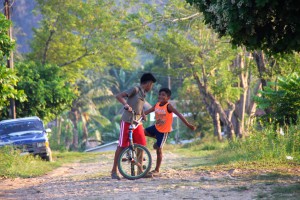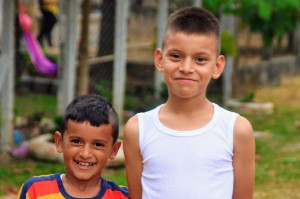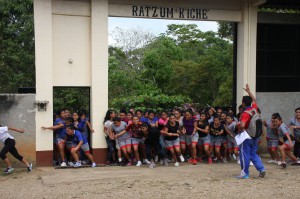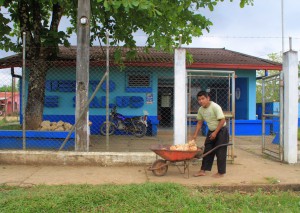I am living in Boloncó, a small village in the Alta Verapaz region. This region is known to be the poorest, and also the most dangerous region in Guatemala. The latter I have not experienced as of yet. The people here are beautiful; they are welcoming and kind. The closest town is Fray Bartalomé de las Casas, a 50 minute drive along a bumpy ‘road’. The area has a tropical rainforest climate and much of its economy has been built on the cultivation of palm oil. Much to my excitement, it is also well known for cacao and coffee plantations.
I am living at ‘Centro de Promoción Feminina de Ratz’um K’iche’, a school which promotes the education for young indigenous girls. Many families do not value the importance of education of young women and this area is known to have the highest rates of illiteracy in Central America. The initiative was established 20 years ago and has been supported by Vitamundi, an association based in Spain, which in addition to educational volunteering, provides health volunteers to provide free medical assistance in the area.
‘¿Hablas español?’. That is the first question I have to ask before I start each consultation. Yes, that does mean, ‘Do you speak Spanish?’. And no, that wasn’t an error. I have quickly learnt that there is no hope that anyone will speak English here, and I have soon become adapted to this. However, if this was not challenging enough, Spanish isn’t even the first language of many of the people here. Q’eqch’í is the native tongue of the indigenous Mayan people who inhabit this area. And not all have learnt Spanish. As if speaking Spanish all day wasn’t tiring enough; try listening to the nurse speak in q’eqch’í, before turning to you and translating in Spanish. I was mentally exhausted by the end of the first day.
The first week was a challenge on a number of levels. After just arriving in Boloncó, which reaches a humid 35 degrees celsius during the day and where no one speaks a single word of English; it was all rather daunting and overwhelming. It however hasn’t taken long before I have started to feel more competent, and with this, I have been thoroughly enjoying the interactions with locals. Being a small village, many of the patients I see during the day, I will often see later in the street. Sometimes I am invited into their home; other evenings, I find myself playing football with the kids in the street. I wave hello to the man in the shop as I walk to work as he asks me each day if I have been for my run yet. I have been asked several times why I am running, and it is not uncommon that people think I am in fact running from something. The concept of running for exercise is somewhat of a foreign idea. I am becoming accustomed to life here. I am forming relationships with locals, I am playing football with a local women’s football team and my language is improving progressively.
At the medical centre, I am also beginning to feel more competent. My days at the ‘Puesto de Salud’ begin at 8am. Usually I am involved in taking consultations, and the distribution of the basic medications that are available here. We do not have the facilities to do laboratory tests or imaging, and anything complicated or requiring emergent treatment is sent to Fray, where the closest hospital is located. Much of the basic equipment that is normally available in a GP in NZ is also not available here. I believe my time in RMIP (rural medical immersion programme) last year has helped to equip me for this ability to cope with uncertainty and to learn how to use clinical impression to manage and treat patients.
Each day brings new challenges, both with communication and with medicine. However, it is also extremely rewarding and I truly appreciate the relationships and connections I have been forming with my patients and with the people in the community





No comments yet.
Leave a comment